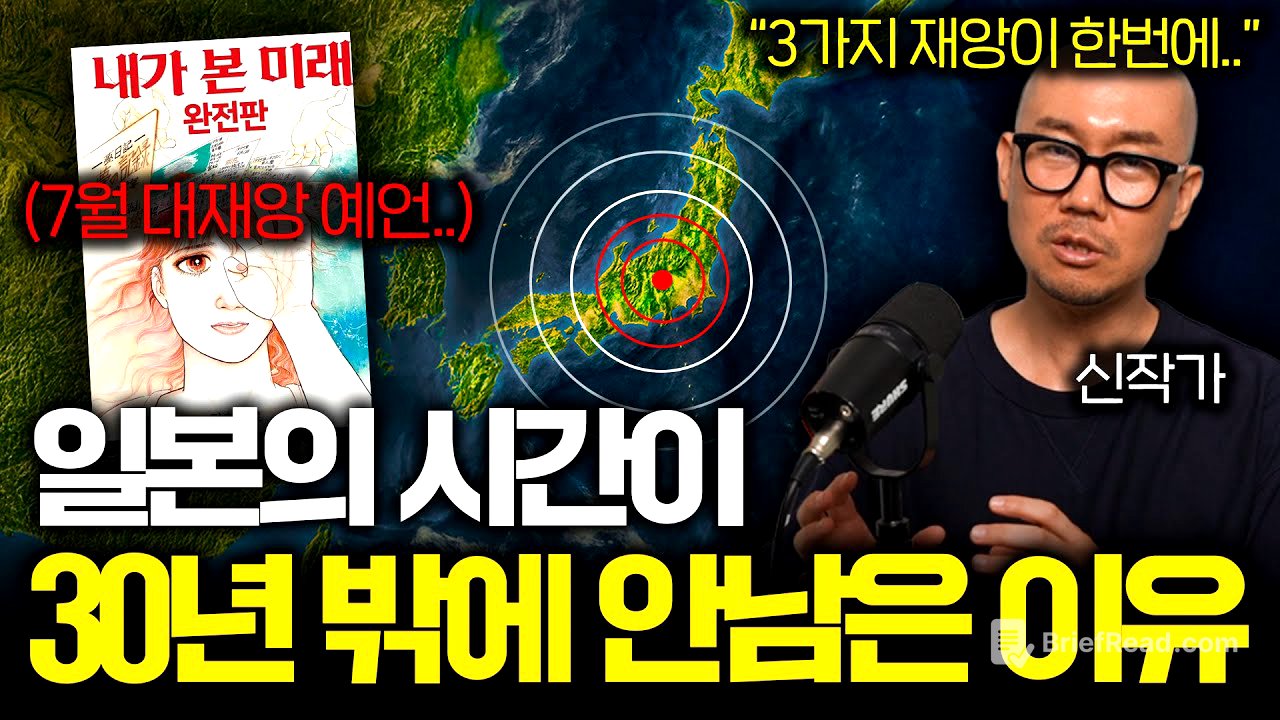TLDR;
The video discusses the potential for a major earthquake in Japan, focusing on the Nankai Trough earthquake, predictions from a book called "I Saw It," and potential impacts on surrounding countries. It covers the likelihood of the earthquake, potential economic and social consequences, and reactions from the Japanese public and neighboring countries.
- A bestseller predicted the 2011 earthquake and now forecasts a major disaster on July 5, 2025.
- Experts predict a high chance of a Nankai Trough earthquake within 30 years, with potential for a triple disaster including a capital region earthquake and Mount Fuji eruption.
- The economic impact could be four times Japan's GDP, leading to potential financial crisis and increased Chinese influence.
올해 7월 5일 일본 대지진을 예언한 베스트셀러? [0:00]
The video starts by referencing a bestseller book called "I Saw the Future" by Katsuki Ryo, which accurately predicted the 2011 Tohoku earthquake. The book forecasts a major earthquake and tsunami on July 5, 2025, originating between Japan and the Philippines, with three times the impact of the 2011 disaster. This prediction has caused considerable concern in Japan and South Korea. The author connects this prediction with the increasing concerns about the Nankai Trough earthquake, amplifying fears in Japanese society.
실제로 일본에 예견되는 재앙급 지진? [1:55]
The primary concern in Japan is the Nankai Trough earthquake, which many experts believe is highly likely to occur within the next 30 years. The Japanese government has increased its estimate of the probability of this earthquake to 80%. There have been several precursory signs, including reports of a widespread rubber-burning smell in Yokohama and mass die-offs of fish washing ashore. Additionally, there has been frequent seismic activity, with nearly 500 earthquakes recently recorded near the Tokara Islands.
일본 열도에 닥칠 3가지 재앙? [4:29]
Japanese experts are concerned about a worst-case scenario involving the simultaneous occurrence of the Nankai Trough earthquake, a capital region earthquake, and the eruption of Mount Fuji. The Nankai Trough earthquake, expected to occur every 80 to 100 years, last happened in 1944. A capital region earthquake in Tokyo could paralyze the nation due to the city's concentration of political, economic, and cultural functions. The scale of damage from the Nankai Trough earthquake is predicted to surpass that of the 2011 Tohoku earthquake.
지진 복구에 일본 GDP 4배 비용이 든다? [6:44]
The economic impact of the Nankai Trough earthquake is estimated to be 1,410 trillion yen, while a capital region earthquake could cause 101 trillion yen in damages. If both occur simultaneously, the total cost could be four times Japan's GDP. Post-disaster scenarios suggest the Japanese government might implement deposit freezes to fund reconstruction efforts. The video speculates that Japan may seek financial assistance from the U.S. and China, with China potentially becoming a major investor in Japanese land, leading to increased economic influence.
개인 벙커를 마련하기 시작한 일본인들 [9:06]
There are observable changes in the behavior of Japanese citizens. Some municipalities are offering earthquake shelters as part of their "hometown tax" programs, where taxpayers can donate to specific regions in exchange for benefits. There has been an increase in companies manufacturing affordable shelters and a rise in the purchase of earthquake preparedness supplies, such as portable gas stoves, due to concerns about disruptions in gas, water, and electricity services following a major earthquake.
일본 대지진에 영향을 받는 주변 국가들? [10:55]
Hong Kong is seeing a noticeable increase in canceled travel plans to Japan, indicating heightened sensitivity to the earthquake predictions. Taiwan is also closely monitoring the situation, fearing that China might exploit the chaos following a major earthquake to invade. Despite these concerns, South Korea, which sends the most tourists to Japan, has not shown significant changes in travel patterns. The presenter notes that the concerns about the earthquake seem to be limited to East Asia, with little attention in Western countries. The author of "I Saw It" has clarified that July 5th is not the date of the tsunami, and the Japanese government has stated that there is no expectation of a disaster on that day. The presenter concludes by noting that a major earthquake in Japan could impact the South Korean economy and potentially cause physical shifts in the Korean Peninsula.









